AVADirect Clevo P170EM: Has AMD’s HD 7970M Got Game?
by Jarred Walton on October 2, 2012 1:35 PM ESTBattery Life and Power Draw
If we discount the overall design and build quality, so far we’ve seen very good performance from the P170EM with some nice LCD options as well. As noted earlier, however, battery life is not one of the strong points of Clevo in general, and the P170EM falls far short of the competition. We’re dealing with an Enduro equipped notebook, so when the dGPU isn’t being used it’s totally powered off—and the same goes for the Optimus version. If we take the Samsung Series 7 and Alienware M17x R4 as our baselines for what to expect from a 17.3” notebook and factor in battery capacities, the P170EM and its 77Wh battery ought to be able to deliver somewhere between 293 to 439 minutes of idle battery life. The Alienware M17x actually isn’t all that optimized for power use, while the Samsung Series 7 is clearly tuned for power savings when set to the “Power Saver” profile. We set the P170EM for ~100nits (28% brightness in this case, which actually results in around 130nits—the next step down at 14% brightness gives 70nits, so we opted for a slightly brighter display) and ran our standard battery life tests…

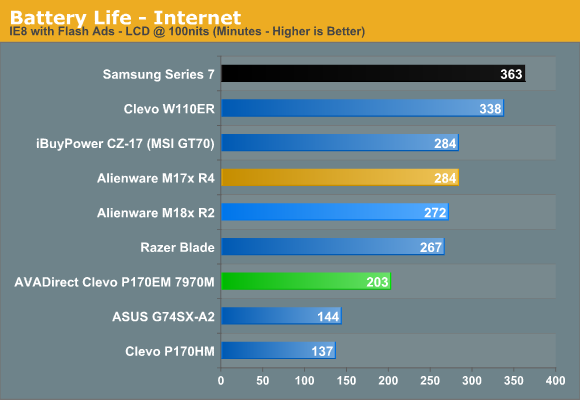

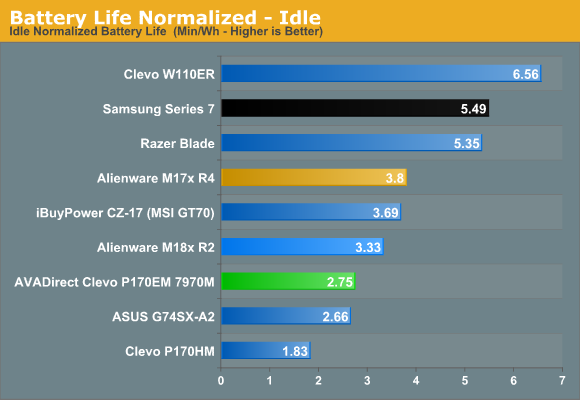
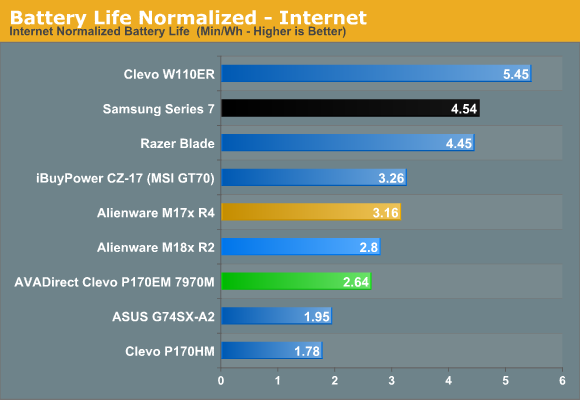
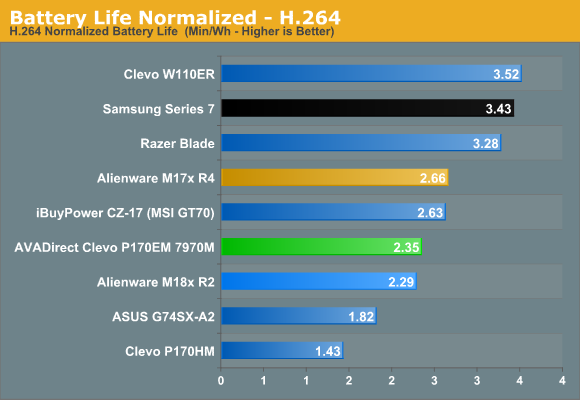
…And that’s what you get when a company doesn’t pay much attention to tuning a design for lower power use. What’s shocking is that the difference between our best-case Idle test and our worst-case H.264 test is only 31 minutes (17%); on the Alienware the difference between those same test results is 43% while on the Samsung it’s a whopping 60% difference. I’m not sure exactly what Clevo is or isn’t doing here; I’d assume some of this is just firmware/BIOS code, but it could be the motherboard capacitors, fans, routing of signals, etc. is simply not done efficiently. More to the point, it almost looks as though the dGPU isn’t powering down properly when it’s not being used. I have no way to really confirm that, but I would estimate the dGPU would use at least 10W of power at idle and that’s basically the difference between the P170EM and the Samsung.
If you really want to punish the battery, you could even try to run a game while unplugged. We set the system to the “Balanced” profile but set AMD’s PowerPlay to “Maximize Performance”, which basically means don’t limit the GPU clocks even if you’re on battery power. You basically get full gaming performance with these settings, but the battery only manages ~40 minutes before going dead. Not that we expect any better—we’re talking about a 45W TDP CPU and somewhere around 100W TDP for the HD 7970M, plus all the various other devices. All told, the estimated power draw for such a load is around 160W, and our real-world testing gives us a power draw of around 115W.
Thermals and Noise
Battery life is a pretty serious disappointment, even for Clevo, but there are still some good elements to discuss. As big and bulky as the P170EM chassis is, you’d expect some good thermals—and it delivers. We ran the same stress test that we used on the Dell XPS 15 and Samsung Series 7—looping the x264 2nd Pass encode on six of the CPU cores while playing Batman: Arkham City at max details on the remaining two cores—and recorded CPU and GPU clocks. Unlike the Dell and Samsung offerings, we saw no evidence of CPU or GPU throttling with the P170EM. Here are the charts of the CPU/GPU clocks and the CPU/GPU temperatures during our two hour stress test, plus a screenshot from HWMonitor:
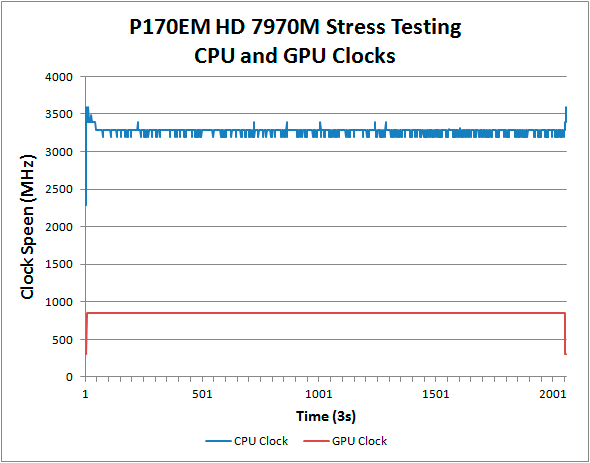
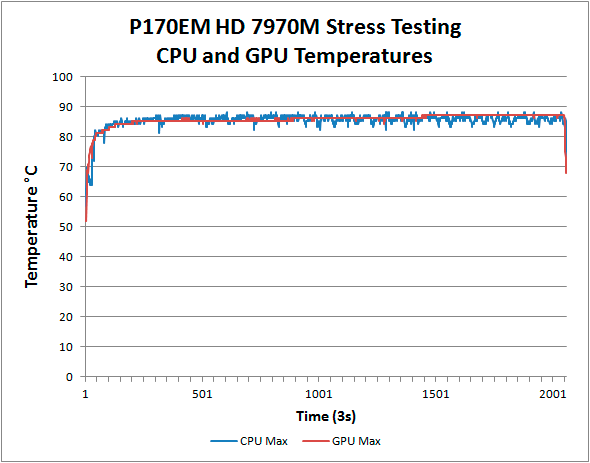
The maximum CPU temperature during our torture testing reaches 88C, which is quite good for a notebook running a high-end CPU like the i7-2720QM. Likewise, the maximum temperature on the HD 7970M is 87C. Those temperatures might not seem all that great until you consider that we’re running at 100% load for two hours with no throttling below the expected maximum turbo clocks (e.g. 3.2GHz on the CPU with all cores active). Clearly the large heatsinks, fans, and exhaust ports are doing their job, though they’re not particularly quiet.
At idle the acoustic noise measures 33.6dB from ~18 inches in front of the P170EM, under 100% CPU load the noise output reaches 38.7dB, gaming pushes the second HSF into action and we get 40.2dB, and during our full stress test we measure 42.4dB. While the idle and load noise levels are noticeable, the character of the noise isn’t all that bad, with a lower whooshing sound thanks to the size of the blower fans. Perhaps more importantly, there’s still another level of fan speed that we didn’t reach during our normal testing; when we set the laptop on our moderately shaggy carpet and covered the exhausts with our hands, after a few minutes of stress testing we were able to hit temperatures on both the CPU and GPU above 90C. The two fans operate independently, and when the CPU hit 90C the noise level jumps to 42.8dB; get the GPU to 90C as well and we get a worst-case noise result of around 46dB. Sure it’s loud at that point, but when the exhausts aren’t blocked the fans move a lot of air—it only took about five seconds after uncovering the exhausts for the temperatures to drop back down to the 85C range.










61 Comments
View All Comments
htwingnut - Friday, October 5, 2012 - link
Wait wut? Work for Sager? Hardly. That's not a very fair comment. I've owned and used most every major brand laptop under the sun. I just happen to own two Sagers at the moment, and over the years has become my laptop of choice due to cost, performance, configuration, and ease of maintenance/upgrading.I don't disagree there could be some things improved, or think that Sager is perfect, but I was countering some issues you brought up that were either incorrect or perfectly personal opinion/bias is all. I even mentioned the keyboard isn't that great, the touchpad is average, and
Sure I would like a magnesium alloy construction, but I understand the cost implications. And as stated there is nothing wrong with the durability of the materials as it stands.
Regarding warranty, I don't think 1 year is great, but it's also pretty standard with most laptops. It's like slamming Ford, GM, or Chrysler for only offering 3/36 warranties on their cars when VW offers 4/50. If you want more, buy more, and at a very reasonable cost compared to competition.
My bad on the battery, it is 79WHr..
I wouldn't consider Sager a "boutique" laptop, it's really a rebranded Sager that they add the components too. There are some really great "boutique" Clevo based laptops, Mythlogic for one, that offer superb support and and great warranties.
In any case I digress.
JarredWalton - Friday, October 5, 2012 - link
Sorry... I just thought I saw something where you said "our [something]" when discussing Sager. I didn't mean it as an attack which is why I put a question mark. If someone officially works for a company and wants to engage in a dialog, that's more than welcome -- we just appreciate knowing who a person is and whom they work for.And in the interest of full disclosure, I believe you do write for Notebookreview -- or is that an unpaid hobby? Anyway, I know my review ruffled some feathers over there, but you know what they say about opinions....
I have edited/toned down/clarified some of the commentary on the keyboard and other elements. My discussion of the build materials was also perhaps not entirely clear. I note that the highest end in terms of materials quality (though it has drawbacks like weight) is doing a machined aluminum build, and that such a design would likely jack up the price $500. But I do feel the addition of brushed aluminum veneers is still "putting lipstick on a pig" -- you can dress up the exterior all you want, but underneath there's nothing special.
Incidentally, I personally find the aesthetic of the P150EM far better than the P170EM, even though it's still mostly plastic. The keyboard still feels the same, but at least there it matches the chassis size nearly perfectly. Because the chassis isn't as large, the plastic doesn't feel as flimsy (not that it's flimsy per se, but everything has more give on a larger chassis), and the soft touch coating is nice -- I'm a sucker for that, but I'm not sure how it holds up long-term.
Finally, regarding boutiques, I basically use that as a somewhat generic label to mean, "They're not a huge OEM and offers more customization options than you can get from a Dell/HP/etc." Some might consider Clevo to be a "large ODM", but for me they're basically a smaller whitebook vendor that targets a market niche, and nearly all of the resellers fall into the "boutique" category. I don't mean this as a bad thing either; I think most boutiques are able to offer a far more personal level of service than what you get from the big guys.
htwingnut - Saturday, October 6, 2012 - link
My reviewing is an unpaid hobby, purely. There's no money in reviewing (well you likely know), at least not enough to support a family on unless you get one of the few lucrative positions out there.I guess we can agree to disagree. Would I like a solid metal chassis? Sure. Is it necessary or practical strictly imho? No.
I find Asus and MSI comparable as far as materials. Alienware is one step up in that regard, but I find the rest of the flashy nature a distraction and unnecessary IMHO.
JarredWalton - Sunday, October 7, 2012 - link
No, I don't think we disagree too much... that is about how I feel about the various options in terms of build quality. I guess the disagreement is: would you pay more for it? If I could get a Clevo with a mag-alloy frame for $100 more, I'd say that would be worthwhile; $200 more would be questionable, and at $300+ more they'd need to have build quality every bit as good as mobile workstations. It could certainly be done, but you may be right: the target market may simply now be willing to pay for it.TrantaLocked - Thursday, October 4, 2012 - link
Clevo has no issue with battery life management. The W110ER is the BEST performing per watt-hour, and it has the same GT 650m and 45W i7 processor as the Samsung. Simply put, the EM series laptops are designed not to save energy as they are targeted at gamers. It won't clock down as much, and the 7970m still needs a lot more energy to run. The Alienware models are based on the 680m, which is quite a bit better with power than the 7970m.JarredWalton - Friday, October 5, 2012 - link
W110ER is best according to what, our charts? That's why I mentioned the SECOND W110ER that I tested, which got battery life as follows:Idle: 217 minutes
Internet: 209 minutes
H.264: 187 minutes
Notice the similarity to the P170EM numbers? And I ran those tests myself (twice on each test, listing the higher result for each). I even tried with two different drives, one an SSD and one a Momentus XT. I couldn't figure out why the battery life was so much worse than what Vivek got with the Eurocom Monster 1.0, though we talked about it later and it's possible the improvement was because he did a clean install of Windows whereas I used the supplied install from Clevo.
Speaking of which, that's an interesting idea: maybe I need to try a clean install of Win7 on the P170EM and see if battery life is the same, better, or worse?
htwingnut - Friday, October 5, 2012 - link
No, battery life using stock Clevo BIOS sucks, period. Latest EC/BIOS helps, getting about 5 hours with basic wi-fi use on W110ER though. So there are improvements being made.The Monster 1.0 battery life is curious at best. But I guess with proper tuning in the BIOS and settings I guess it's possible to exceed 5 hours.
JarredWalton - Friday, October 5, 2012 - link
Realistically, with a properly tuned BIOS and a 62Wh battery, the W110ER ought to be able to last 8+ hours. Look at the Samsung Series 7: 77Wh battery and a 17.3" LCD and it manages over seven hours idle and six hours Internet. There's no reason an Intel-based laptop can't come close to the numbers put up by AMD's Trinity, especially in light use scenarios. I've actually got a dual-core IVB laptop in now, so I'm going to be interested in seeing what sort of battery life that gets (Dell Latitude E6430s if you're curious). My bet is it will be about equal to Trinity in efficiency.htwingnut - Saturday, October 6, 2012 - link
Part of the issue in the W110ER is how it handles Optimus. Until recent drivers the GPU never fully shut down (so we think based on some anecdotal evidence). 305.53 and latest driver seem to do it properly. Where system was draining 14-15W with wi-fi on, 40% brightness, it now draws 11-12W. For a 45W CPU, I find that about normal. The latest ME, EC, BIOS updates do help quite a bit. I am getting over 5 hours just casual use with a dual core i5-3360m that I'm testing at the moment. Will compare against the i7-3610QM when done.For 8 hours battery the W110ER would have to consume no more than 7.5W. That means 7.5W total for wi-fi, lcd, CPU, RAM, HDD/SSD. Not very realistic. That's about the power drain of the M11x R1 with a 10W ULV CPU. The LCD in the W110ER also has a high power draw for such a small screen.
The Samsung Series 7 is quite spectacular for sure. I'm curious however if Samsung employed some voltage reduction measures and dropped CPU speed to achieve that power draw. Can you check voltage and CPU speed at idle unplugged on that machine? Using Throttlestop I can drop speed to 800MHz, but voltage is same so it doesn't really matter. Samsung are also masters a optimization. Not an excuse for Clevo or any other manufacturer, but in the end, it also does affect cost. A 17" with low end quad core and GT 650m for $1350 compared with laptops for $400-$500 cheaper with similar specs.
JarredWalton - Sunday, October 7, 2012 - link
With an 11.6" LCD, I think 8W idle is perfectly realistic with Ivy Bridge. M11x actually isn't that awesome on power savings either; I've seen quad-core Sandy Bridge draw only 10W idle with a 17.3" LCD, though.As for the Samsung Series 7, idle clocks are 1.2GHz, just like they should be. Voltage on the CPU is apparently 0.826 to 0.846 at those clocks; I assume there's some "luck of the draw" there, but I don't know what normal is supposed to be.
Anyway, you're probably right: with the latest drivers and firmware updates, the W110ER should be doing much better than the second unit I tested, and hopefully close to what we measured on the initial Monster 1.0 review.